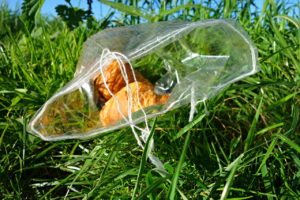 Food packaging is not a subject that gives a lot of people sleepless nights. Packaging is considered a waste product. It’s something we remove from our groceries and put in the bin as soon as we return from the supermarket. Our food, especially fruit and vegetables, look more authentic without it and we don’t feel it has any value. On top of that, it creates enormous piles of waste.
Food packaging is not a subject that gives a lot of people sleepless nights. Packaging is considered a waste product. It’s something we remove from our groceries and put in the bin as soon as we return from the supermarket. Our food, especially fruit and vegetables, look more authentic without it and we don’t feel it has any value. On top of that, it creates enormous piles of waste.
Consequently a number of charities and environmental organisations have sprung up over the last 10-15 years advocating for consumers to buy unwrapped fruits and vegetables, to buy in bulk instead of smaller boxes and packages, and to buy fresh fruit and greens instead of frozen or tinned products; all in an effort to reduce unnecessary packaging and create less waste that needs to be disposed of. There are even those who have encouraged people to remove packaging from their groceries before leaving the shop as a form of civil protest; to tell the stores and manufacturers that we want less packaging, not more.
Reduced packaging increases food waste
The problem here is that a lot of the advice aimed at reducing food packaging, ends up increasing food waste instead. We buy a large bag of salad instead of a small, and then we don’t manage to finish before it goes off. We buy unwrapped fruit and vegetables that’s been prodded and poked by other people in the shop, and therefore goes off sooner than we expected; so again we don’t manage to eat it all before we have to throw it away. Food waste occurs throughout the production chain, but a large part of it comes after the product is bought by the consumer. A comparative study found that in both the UK and the US we throw away about 25 percent of the food we buy.
The Bigger Picture
How do we square that circle? Wasting food or creating waste? And of the two issues, which is most pressing when we look at the bigger picture?
The Food and Agricultural Organisation of the United Nations (FAO) published a report in 2011, estimating that each year, one third of all food produced for human consumption is wasted. That amounts to about 1.3 billion tons per year. Other estimates are even higher; some say up to 50 percent. This means that we are no longer able to produce enough food to feed all seven billion people on our planet. Consequently, around 1 billion regularly starve.
On the other hand, how much energy is spent on producing the packaging for our food? Packaging that protects it during transport and makes it last longer. Packaging that consequently reduces food waste, because less of it will go off before we have the chance to eat it.
Of the total amount of energy needed to get a food item to our kitchen table, around 80 percent is spent on producing the item itself, 15 percent on transport and only 5 percent on the packaging. So, if somewhere between one third and half of all the food produced on this planet every year is wasted, and 40 percent of that is wasted in the retail and consumer level, maybe those 5 percent spent on packaging is not the biggest issue?
The smaller issue
Yes, the packaging used to prevent and reduce food waste will of course still have be disposed of, but there are other options than to dump it in a landfill, where it will take hundreds of years to decompose.
Efficient bottle deposit schemes can ensure that drinks bottles and cans are recycled (or even re-used) instead of ending up in the sea and other places where they doesn’t belong. In Denmark such a system has existed for many years, and the recycling percentage is now 90%. The deposits from the 10% unreturned bottles are used to fund and improve the system.
It is also possible to burn plastic (and other) waste in in specialised power plants and create electricity and energy for heating that way. It creates a certain amount of CO2, but burning one ton of waste only creates a fourth of the CO2 burning a ton of oil would. Again, Denmark has such a system, and it works. Only four percent of all plastic waste in Denmark isn’t either recycled or burned to create energy.
In my opinion, we should therefore not focus on reducing packaging, but on reducing food waste. With proper recycling systems in place to make it easy for customers to sort their waste; and bottle deposit schemes like the Danish, waste from packaging need not be the problem it is today.
Combine recycling and burning with increased research into new forms of compostable packaging and we can hopefully get to a stage where we can produce enough food. That way, everybody can go to bed with a full stomach every night.
